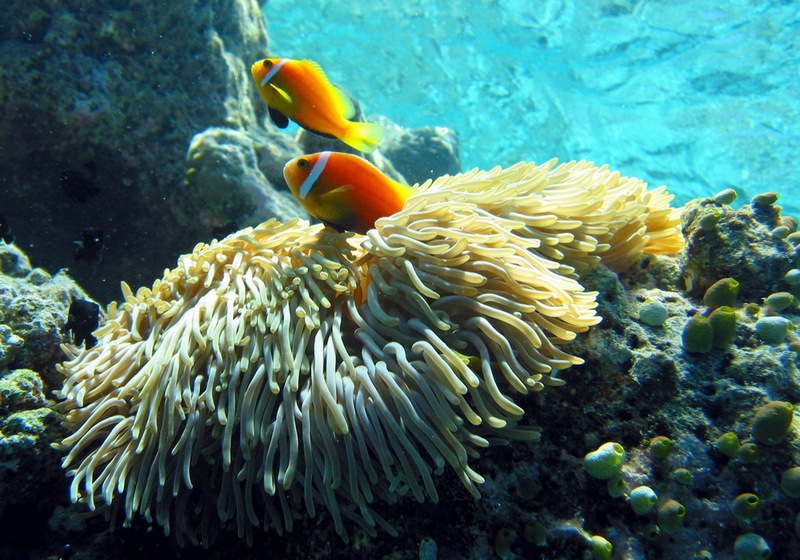Clownfish (Subfamily: Amphiprioninae) - Wiki Clownfish
From Wikipedia, the free encyclopedia
[Photo] Maldive anemonefish (Amphiprion nigripes) in a sea anemone (Heteractis magnifica). They are sometimes called Black-footed clownfish due to their black pelvic and anal fins. On the right side rock there are a couple of Sea squirts visible. Photographed by Jan Derk (http://en.wikipedia.org/wiki/User:Janderk) in March 2006 in Fihalhohi, Maldives.
The clownfish, or anemonefish, are the subfamily Amphiprioninae of the family Pomacentridae. Currently 27 species exist, of which one is in the genus Premnas and the rest are in the subfamily's type genus Amphiprion. The other pomacentrids are called damselfish.
Ecology and life history
Habitat
Native to wide ranges of the warm waters of the Pacific and Indian Oceans; some species ranges overlap others. Clownfish are not found in the Atlantic Ocean. Clownfish live in a mutual relationship with sea anemones, or in some cases settle in some varieties of soft corals, or large polyp stony corals when an anemone is not available. If the fish settles in a coral, it could agitate the fish's skin, and in some cases, may kill the coral. Once an anemone or coral has been adopted, the clownfish will defend it.
The anemone is required in nature because reef life is dangerous for small, brightly coloured fish; in an aquarium lacking predators it is not needed. For this reason, clownfish never stray far from their host. In an aquarium, where they don't have to forage for food, it is very common for clownfish to remain within 6 to 12 inches of their host for an entire lifetime.
Clownfish and damselfish are the only species of fish which can avoid the potent stings of an anemone. There are several theories for how this avoidance is accomplished. Firstly, the slime coating of the fish may be based on sugar rather than proteins so anemones fail to recognize the fish as food and do not fire their nematocysts, or sting organelles.
Secondly, the mucous coating may mimic the anemone's own coating, a theory that is bolstered by the fact that it takes several days for a clownfish to adapt to a new species of anemone. There is no adaptation period when a clownfish is moved to another anemone of the same species.
Thirdly, their unique movements, which are unlike any other fish, may let the anemone know that they are not food. This theory is bolstered by the fact that juvenile clownfish, which have no coating, will immediately seek refuge in any compatible anemone and will not be stung. Juvenile clownfish will not survive for long without the protection of an anemone, and few find one before being eaten.
Clownfish live in their anemone in groups. Usually a female lives with other males. When the dominant female dies the head male changes sex and becomes the female.
Clownfish lay eggs on any flat surface close to or under the protection of their host anemones. In the wild, clownfish spawn around full moon and the male guards them until they hatch about 6 to 10 days later, typically 2 hours after darkness starts. Clownfish are omnivorous: in the wild they eat live food such as algae, plankton, molluscs and crustacea; in captivity they can survive on live meat, fish flakes and fish pellets. They feed mostly on copepods and mysids, and the undigested excrement from their host anemones.
Species
Twenty-seven, including:
Amphiprion allardi - Allard's clownfish
Amphiprion melanopus - Cinnamon clownfish
Amphiprion clarkii - Clark's anemonefish
Amphiprion ocellaris - Ocellaris clownfish
Amphiprion percula - Percula clownfish
Amphiprion perideraion - Pink skunk clownfish
Amphiprion polymnus - Saddleback clownfish
Amphiprion sebae - Sebae clownfish
Amphiprion bicinctus - Red Sea clownfish
Amphiprion tricinctus - Three-band anemonefish
Amphiprion ephippium - Red saddleback anemonefish
Amphiprion frenatus - Tomato clownfish
Amphiprion chrysopterus - Orange-fin anemonefish
Amphiprion akallopisos - Skunk clownfish
Amphiprion sandaracinos - Orange skunk clownfish
Amphiprion rubacinctus - Australian clownfish
Premnas biaculeatus - Maroon clownfish
http://en.wikipedia.org/wiki/Clownfish
| The text in this page is based on the copyrighted Wikipedia article shown in above URL. It is used under the GNU Free Documentation License. You may redistribute it, verbatim or modified, providing that you comply with the terms of the GFDL. |
